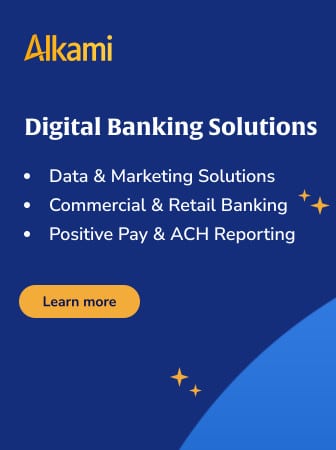Social: A Game Changer
The cost of doing nothing in social media? You lose business, both on the customer acquisition side and the attrition side, because customers who expect you to engage with them in these new media will go somewhere else when they see that you’re not. Social media has become the new “word of mouth.” What people say about your brand is more important than what your bank says about itself.

Join industry’s leading AI conference - free passes available!
Ai4 is coming to Las Vegas, August 12-14 2024. Join thousands of executives and technology innovators at the epicenter of the AI community.
Read More about Join industry’s leading AI conference - free passes available!

Accelerate Time-to-Market with Rapid Implementation
Create a sustainable competitive advantage with faster time to market by drastically reducing implementation time.
Read More about Accelerate Time-to-Market with Rapid Implementation
31. Do you have a presence in any social media networks? Do you know the right ones for your bank?
Social is an investment into your bank’s reputation that, over time, becomes an effective tool for building trust. That requires participation on a personal level in a meaningful way to build real human relationships. Where you should participate is usually dictated by your business goals and your brand messaging. Figure out whom you are trying to talk to (with what message) and then find out where they spend their social time online.
Is it Facebook, Twitter and LinkedIn? Perhaps, or maybe Pinterest or YouTube is big among certain target groups. Tip: Don’t forget online discussion forums. A recent report from Social Media Explorer shows that 90% of conversations about banking and banking products happen in forums rather than social networks.
32. Do you have social media guidelines and policies established and do they meet compliance requirements?
Every organization should have a well thought out set of policy documents governing the use of the Internet and of social media by the organization and clearly defined terms of use for site visitors. That is the minimum cost of entry for the usage of the online platforms.
Add to that the areas that are more administrative or operational such as compliance and legal. Compliance is typically the reason listed by banks and credit unions for not participating in social media. It’s ironic then that the recently proposed FFIEC regulations regarding social media will also affect banks that don’t even have a social media presence, by requiring all banks to come up with a plan to manage customer mentions. Compliance can be effectively managed with diligence and a predetermined workflow that facilitates the necessary reviews.
33. Have you researched the best social media management platforms?
There are so many social media management platforms, tools and services out there you could spend a week looking at them all. Take a few moments to list what you need it to do and use those criteria to select the right one for you. For instance:
Do you need to have an all-in-one (dashboard) view of your social media channels, create efficiencies for posting to multiple networks or measure engagement?
- Hootsuite – Our preferred management platform is HootSuite, a popular social media management tool for collaborating across different social networks. HootSuite’s desktop dashboard lets you see and manage your streams from different accounts and different social networks all on a single page. It also has tracking and measurement tools built into the interface.
- Sprout Social – Sprout Social is a management and engagement platform for social business. It uses a single-stream inbox created to help you keep track of each message. It has a sophisticated tool to seamlessly post, collaborate and schedule messages to the popular social networks. It also has monitoring and analytics tools.
- Buffer – Buffer is a simple way to schedule content across social media. You can fill the virtual queue with content and then stagger posting times throughout the day and also keep a consistent schedule during the week.
Other notable social management platforms include: SocialBro, Postling, Engagor and ArgyleSocial.
34. What have you done to talk with your customers in those spaces?
Customers want convenience and that requires quick, simple, and reliable service that is available everywhere at anytime. Retail banking should become a seamless convenience for the customer – wherever the customer is, especially within social networks. To get the details, you will have to ask them. You can start by finding relevant research, commission your own research or create a small informal survey or questionnaire to ask your customer what they expect from their bank and why.
35. Are you selling products and services in those spaces? Banks are increasingly selling on Facebook, etc.
By 2025, it is estimated that social networks will become the major distribution channel for retail banking products. A recent Accenture survey shows that sales of mortgages via the Internet increased 75%, while sales at branches fell 16%. Online sales of auto loans nearly doubled, while branch sales dropped nearly 10%. Online sales also increased in checking, savings, personal and home equity loans and money market funds.
36. Are you providing customer service in those channels?
Social media, once considered a nontraditional method of customer interaction is clearly becoming increasingly important for banks to understand. It’s no longer just a vehicle for customers to vent about poor experiences or praise their bank for exceeding expectations…it has now become a legitimate service channel.
37. Are you advertising on social media networks?
Facebook has been the most aggressive in developing advertising opportunities for business. Facebook has decently sophisticated planning and analytics tools and is continuously fine-tuning their ability to target Facebook users based on a wide variety of criteria. In fact, most social networks have some paid promotional options that are worth exploring if your customers frequent a specific social network.
38. Do you have a social media command center?
Big banks are making a big statement with high visibility command centers, staffed with social media teams and customer service specialists. Chase Bank and MasterCard both unveiled their social media command centers this year. Wells Fargo upped the ante by announcing plans to open two “social reputation command centers” with the main location in San Francisco and another located in Charlotte, North Carolina. The point of these command centers is not to suggest that you imitate the fancy, studio-like locations. We mention them here to emphasize the corporate commitment to creating a more social business. Bringing social media and customer service together in a collaborative environment is a good idea, whether it’s two staffers or 200.
39. Do you have a distinct head of social media in an executive role?
According to Brett King in his latest book, Bank 3.0, social media is not just an add-on to the IT or marketing function. He asserts that social media is more vital to the future of your bank than your call center, your ATMs or any of your branches. You know that change works best from the top down and that for true transformation to take place social media must become part of the company’s vision and an essential part of the company culture. An executive-level leader can ensure that social media initiatives are all aligned with and driving the business goals of the company.

40. Are you still using mass advertising but in its changed role?
Just because something new comes along doesn’t mean that the previous method should be abandoned. Advertising’s importance has diminished a bit, but it is still efficient at reaching a mass audience. That means that advertising is still a good branding tool to use in shaping and influencing your image and reputation. It also means that advertising may sometimes hold the supporting role by driving web traffic or promoting an online initiative.







